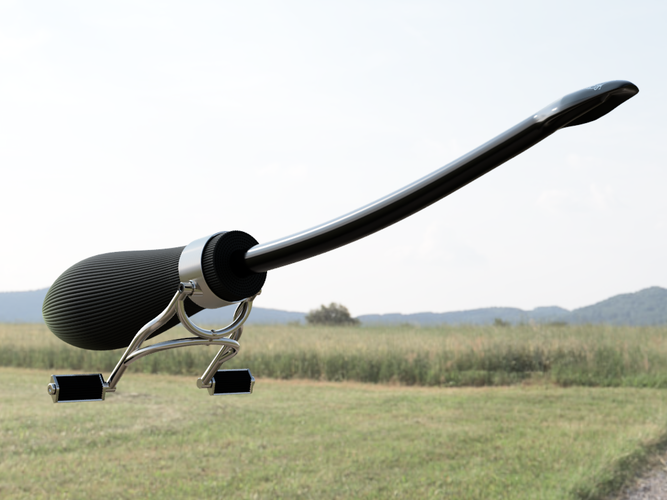
Harry Potter - Draco Malfoy's Nimbus 2001 (full-size) - 30% OFF
pinshape
IF PURCHASING IS STILL DISABLED, PLEASE HEAD OVER TO CULTS 3D TO DOWNLOAD "The Nimbus 2001 is a broom produced by the Nimbus Racing Broom Company as part of their successful line of racing brooms. Released in August, 1992, it was faster than its predecessor, the Nimbus 2000. It officially became the fastest broom in existence, until the launch of the Firebolt in 1993. The broom itself is black and silver with revolving stirrups. Despite the Firebolt being faster, the Nimbus 2001 is still used by the majority of Quidditch teams across the globe." (Harry Potter Fandom Website) Draco Malfoy's Nimbus 2001 Quidditch broomstick featured for the first time in Harry Potter and the Chamber of Secrets (2002). This a full-size replica prop with rotating stirrups and pedals for display and cosplay purposes. It is not an exact replica, but has been modelled from many internet images and video references. When printed as per instructions the prop weighs in at 2.2kg. The stirrups have a limited range of rotation of 100º from flush with the broom to standing position. The handle can be dismounted for easier transit. Tips The prop has been split into printable parts rarely along natural seams, which means that all parts will need to be connected together and all seams sanded until smooth. All parts are pre-orientated for the best print without any need for supports. They can be printed on a printer with a print volume of no smaller than 200mm x 200mm x 240mm. I print all my models with a 0.4mm nozzle and 4x shells (1.6mm) for strength and to provide a thick enough surface for sanding. I highly recommend you do the same as a lot of sanding (or even filing) will be required to clean up all the seams. I recommend printing all large brush parts at 0.32mm layer height for speed and all other parts at 0.2mm layer height to maintain quality and tolerances. No supports will be necessary on any part if printed in the orientation provided. Infill can be kept to a minimum. Brush parts can be printed with 0% infill if printed with 4x shells. All other parts can be printed with between 5% and 15% infill; your preference. If using infill, I recommend a cubic style infill that will offer support in three dimensions. The stirrups are split in cross section and printed vertically in all cases. I recommend printing with a brim to offer additional bed adhesion. Repeatable parts are provided once and their file reference will indicate the number of prints required e.g. 6-01 Pedal [1-2].stl needs to be printed twice. Parts may not be immediately obvious in the way they fit together. I have provided registration indicators for handle parts for you to match the seams. I have marked front and rear faces for the band (important), but in all other cases please refer to the build instructions in the step by step images provided. I recommend that you familiarise yourself with all parts and connections before gluing together, sand them and carry out test fits as you go. Think carefully about the order you're building the model in and if parts need to remain unglued to help with painting and finishing. I recommend Super Glue or any other Cyanoacrylate (CA) based equivalent. One with a 10sec or less setting time is especially useful. Registration pins are used in all connections. 44 pins are required, but print more as you will likely need spares. I recommend printing 50 pins with a brim so you have a 'sheet' to keep them all together. Registration pins are sized correctly, however, from experience of this and other models I find that some work is required to make pins fit. If your printer experiences 'elephant's foot' on the first few layers then you may need to open the edges of holes. If your printer doesn't bridge holes well you may find pins are often too long. I find that if parts don’t fit together properly, an effective method is to fix one end of the pin and then snip it shorter to suit the second part - sharp wire cutters are ideal. The stirrup parts are joined in 3-dimensions. Lay out the parts and test fit them before glueing. The stirrup axles have no markings to identify which is left or right. Refer to the step by step images to ensure you have the correct one. If you fit the wrong one, your stirrups won't rotate the right way. Make the left and right stirrups separately then fit them to the band. Once fitted to the band they will not be removable. You will need some screws. I have modelled clearance and threading holes to suit No.8 countersunk wood screws. I used twin thread, Phillips head screws available from all DIY stores. These will self-thread the holes provided, but take it slowly and do not over tighten or you will risk de-threading or breaking the parts. You will need: 2x 1" No.8 wood screws to stop the pedals on their axles. 2x 1.5" No.8 wood screws to attach the stirrups to the band and adjust rotational torque. 1x 1.5" No.8 wood screw to lock the handle into position. I hope you enjoy building and using this prop as much as I did.
With this file you will be able to print Harry Potter - Draco Malfoy's Nimbus 2001 (full-size) - 30% OFF with your 3D printer. Click on the button and save the file on your computer to work, edit or customize your design. You can also find more 3D designs for printers on Harry Potter - Draco Malfoy's Nimbus 2001 (full-size) - 30% OFF.
